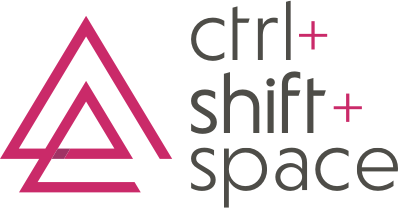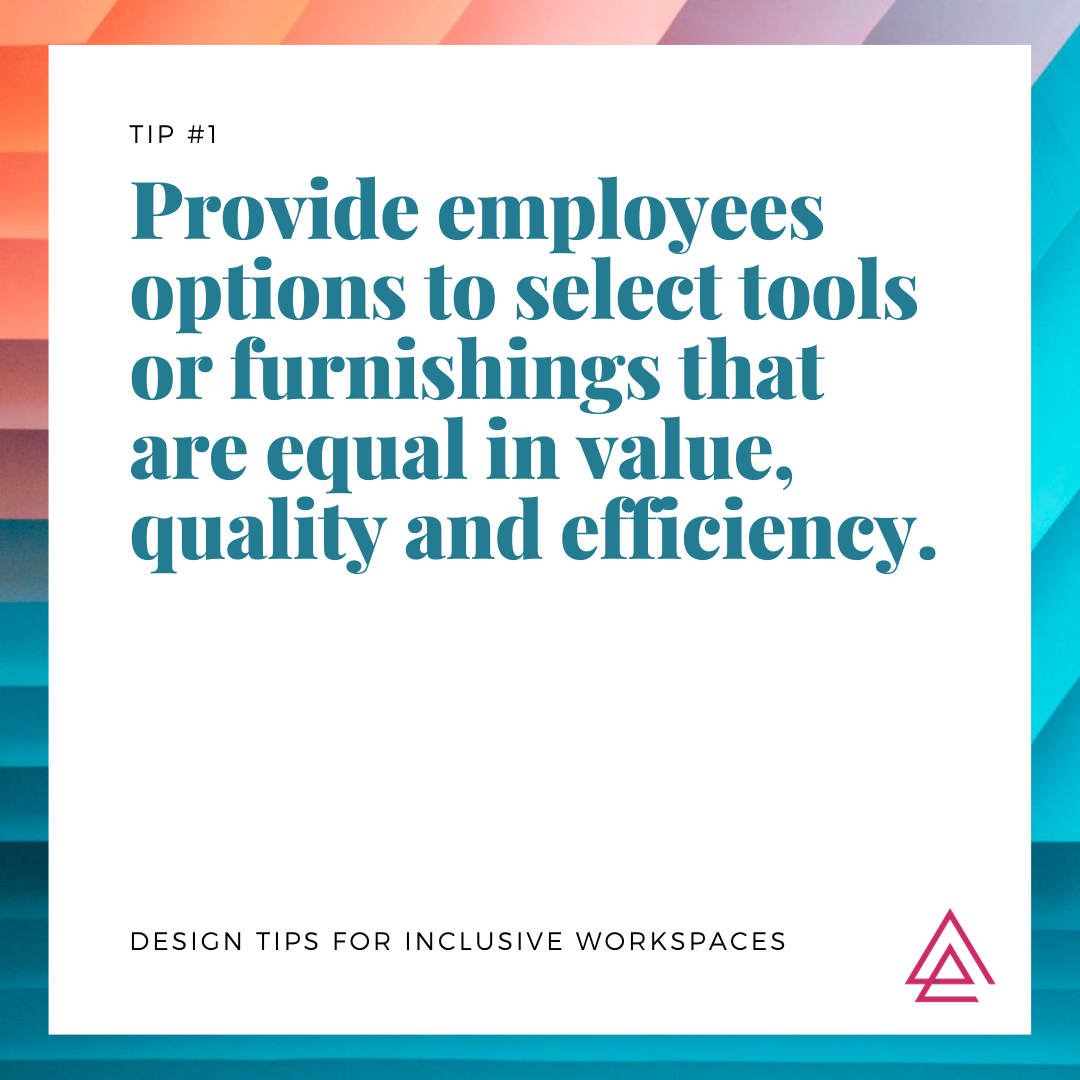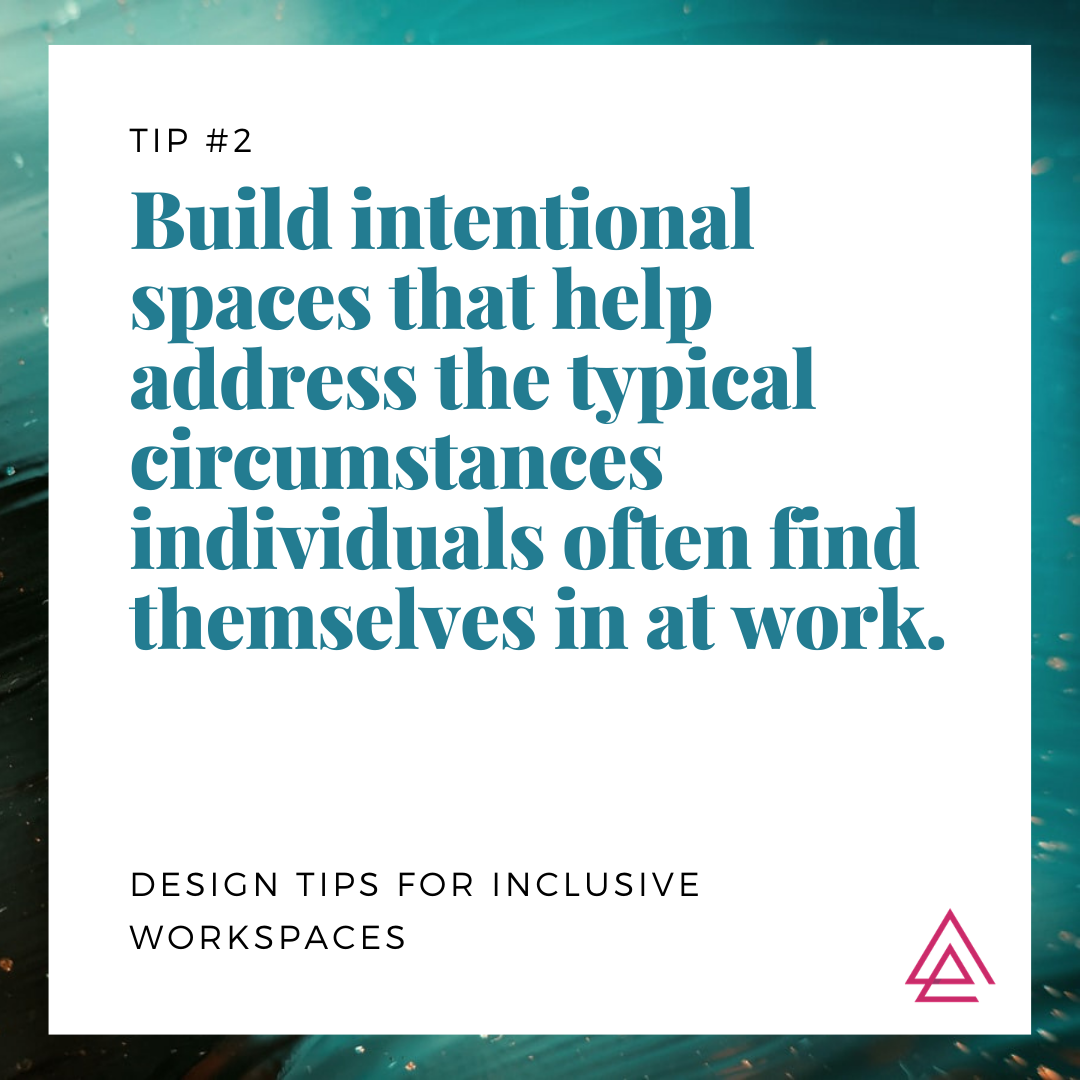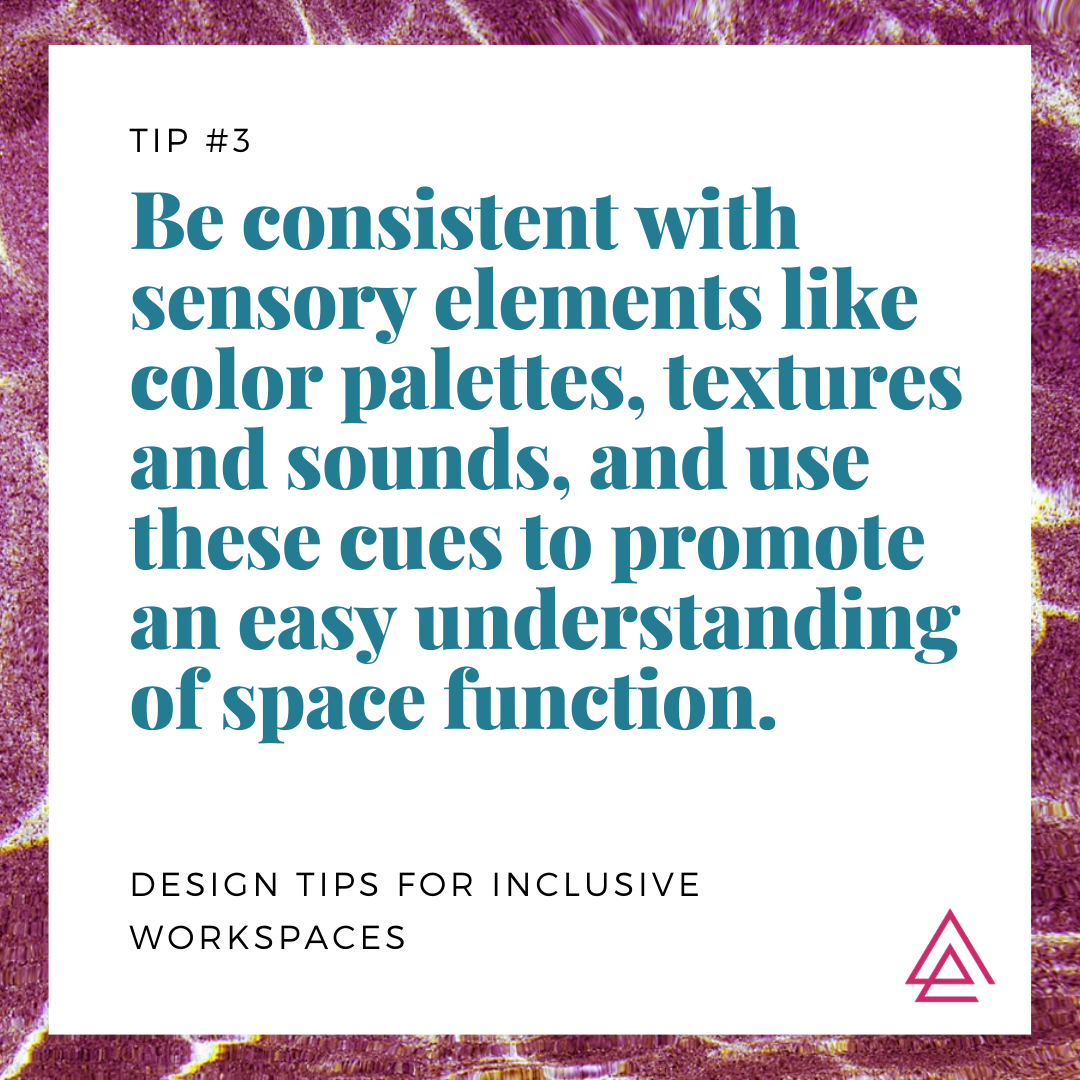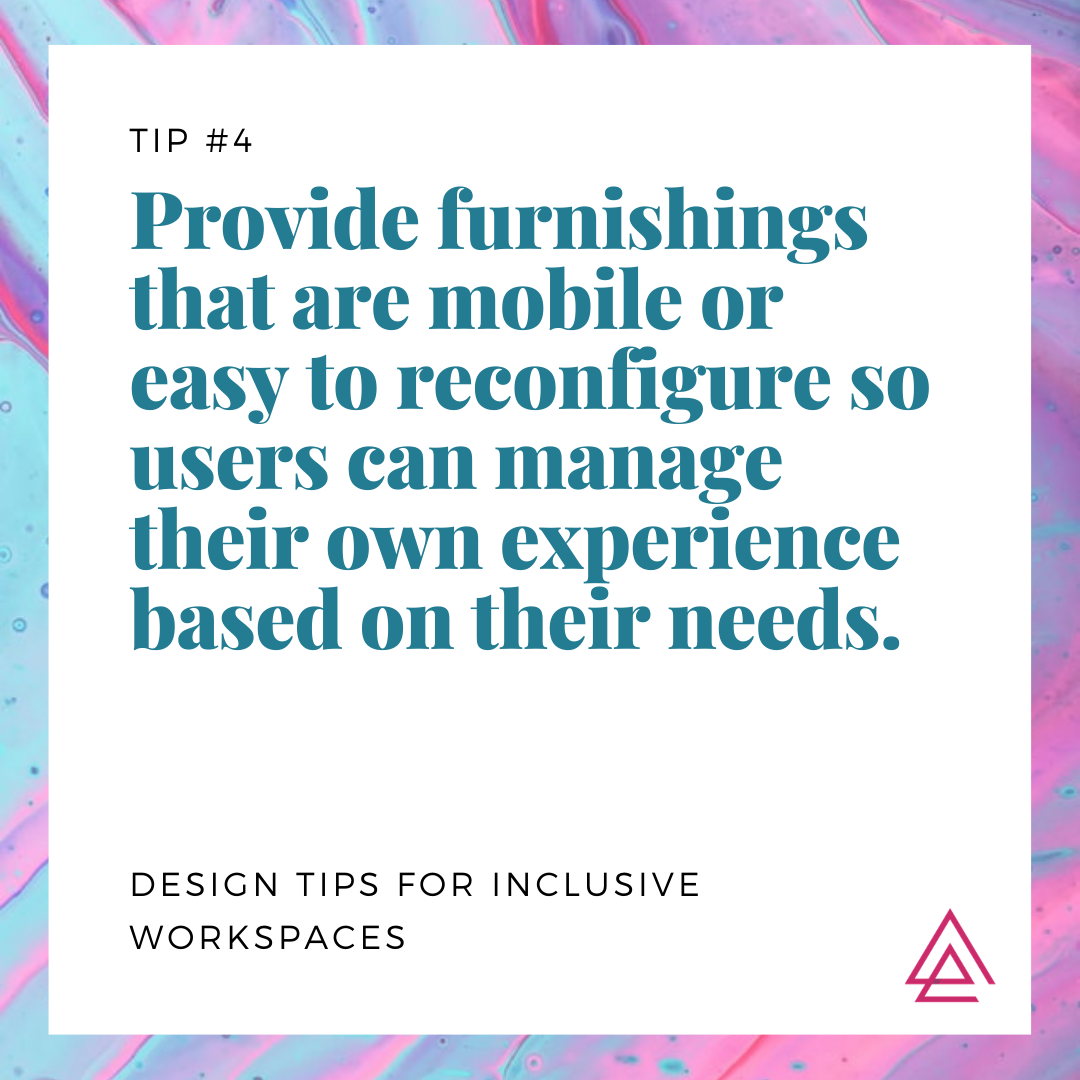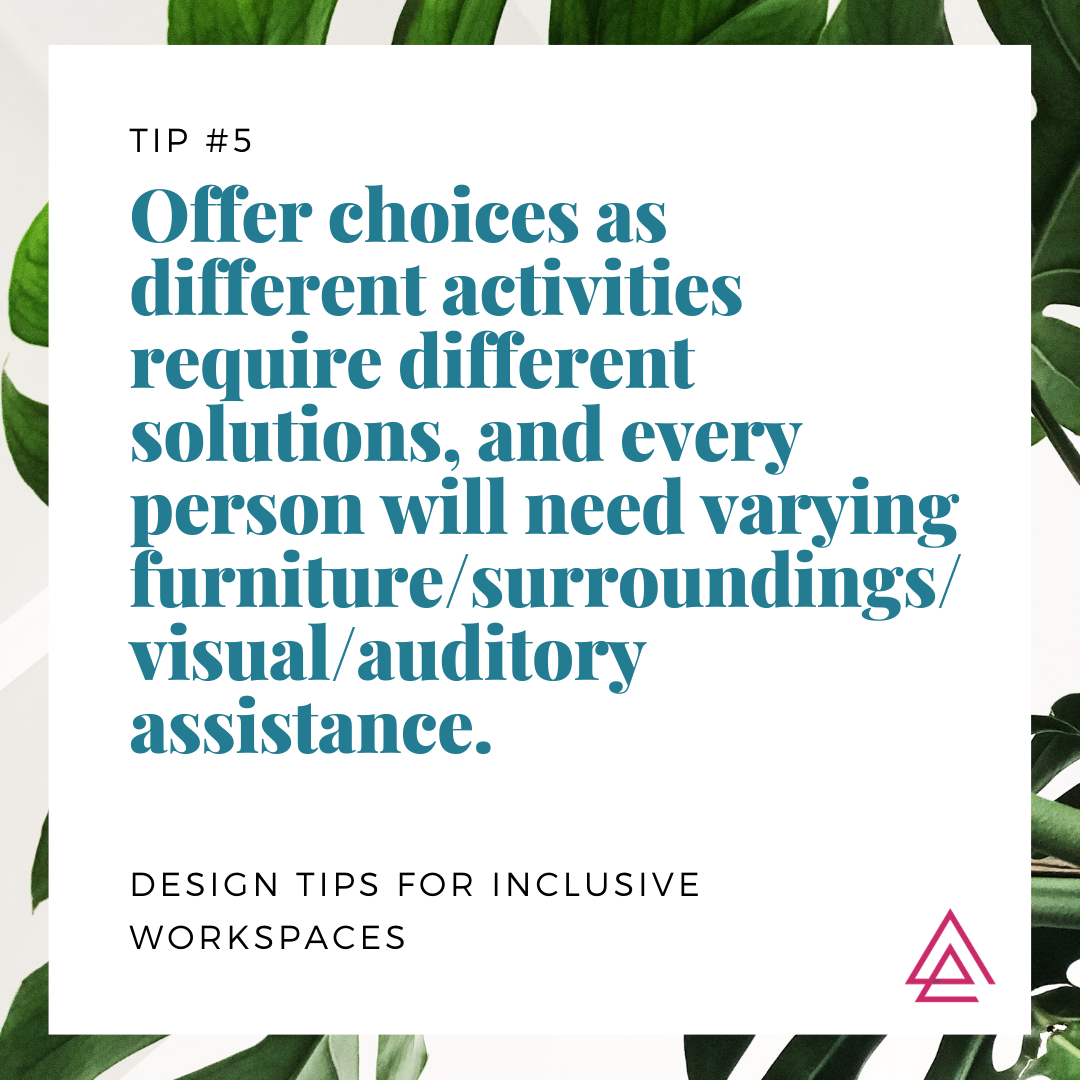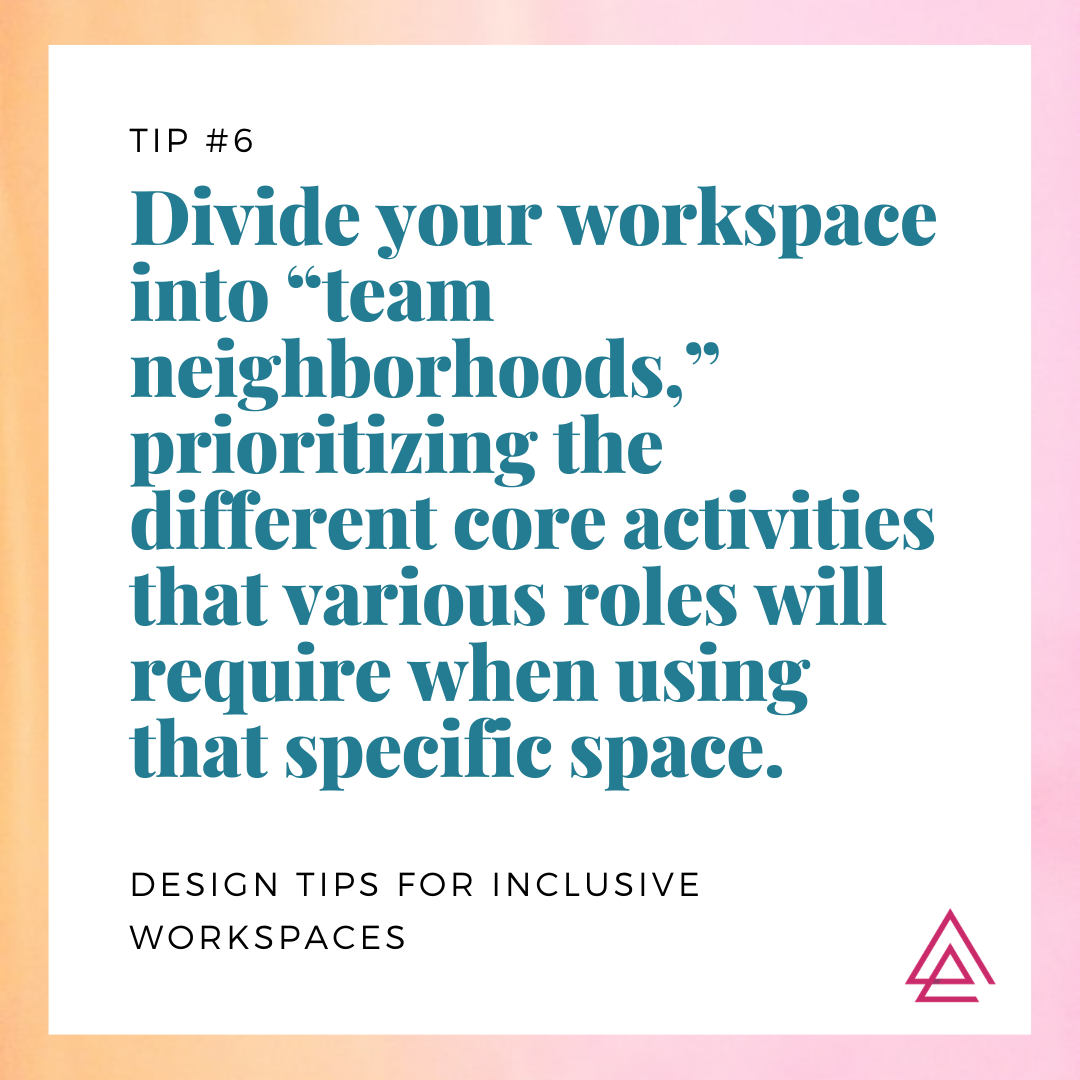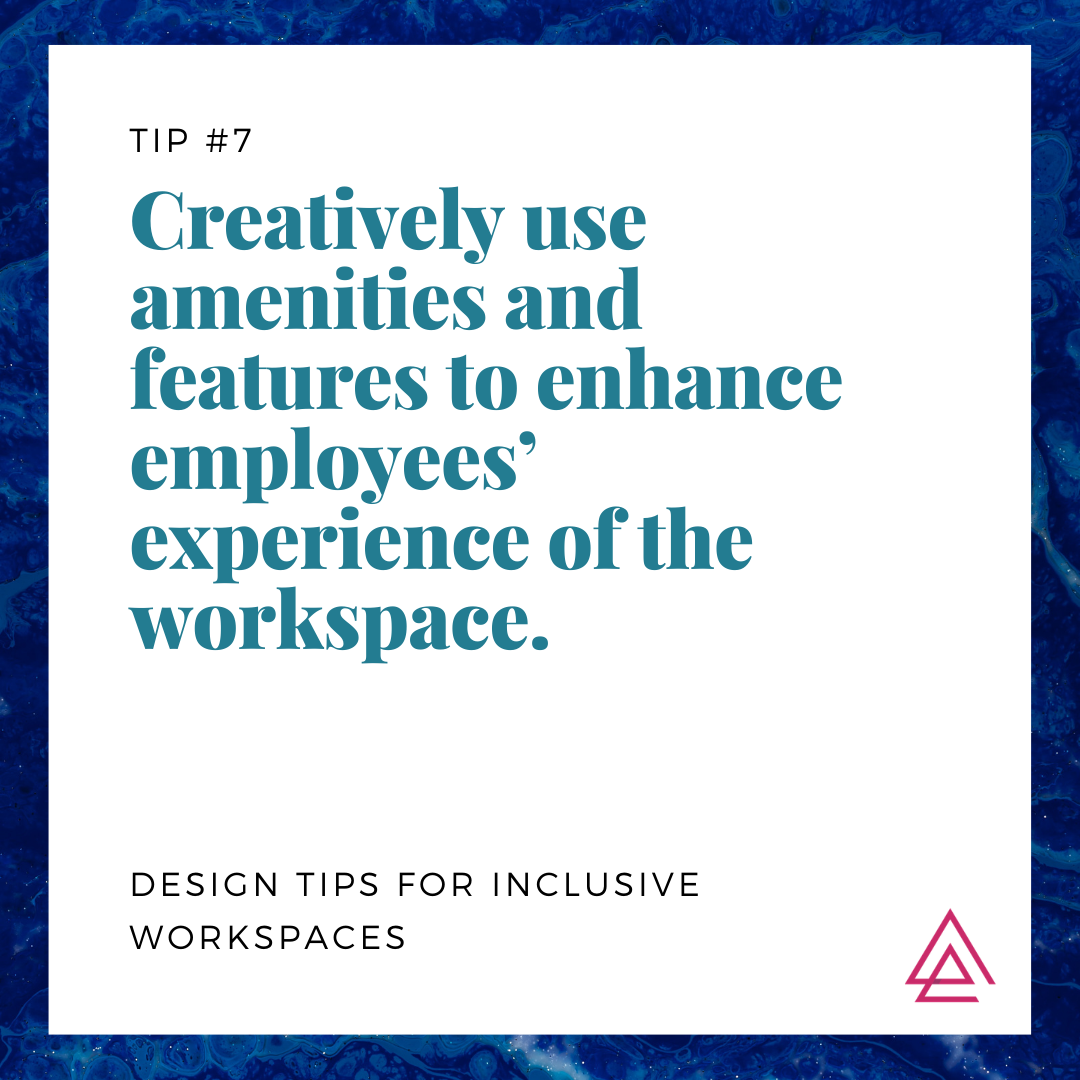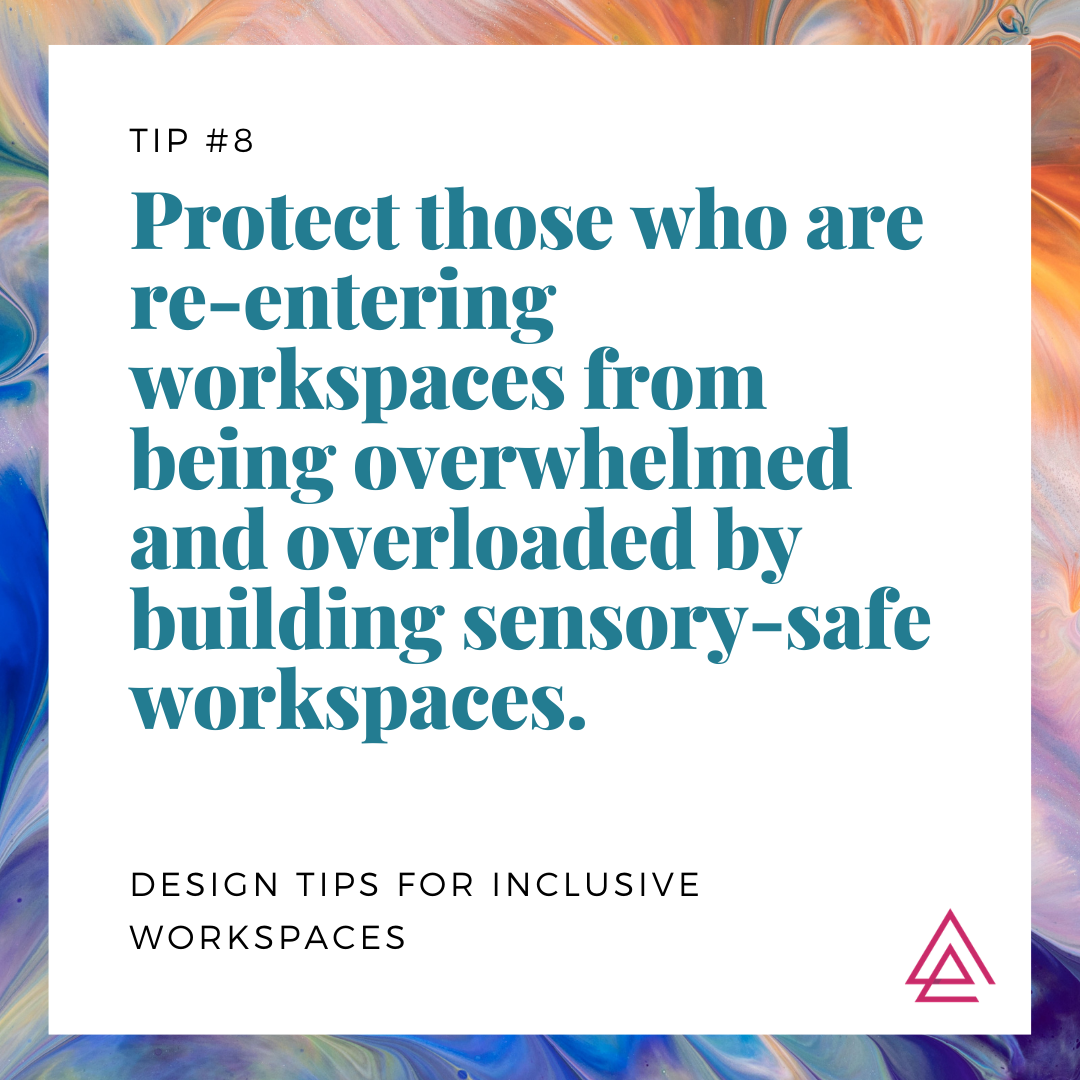A Happy Workplace
“Inclusive Design Principles are about putting people first. It’s about designing for the needs of people with permanent, temporary, situational, or changing disabilities — all of us really.”
It’s hard to remember entirely what life was like pre-pandemic - but with many places reopening due to the vaccines, people are starting to venture out and live life like they used to (sort of). Yet the not-so-fun surprises, like breakthrough cases, continue to round the corners, keeping many communities and families on edge. This state of ‘COVID-being’ continues to take a toll on our minds and our bodies, the effects of which have emerged as an increase in antidepressant prescriptions, burnout and screen fatigue, plus expanded waistlines. Who knows what the next 6 months will bring with variant strains like Delta taking their toll, but one fact remains clear – every one of us is going to come out of this having experienced some form of trauma or another.
Ponder then, what it will mean for our society to heal – as a whole – with such a spectrum of shock and suffering. While we can all rely on motivational speakers, traditional mental health counselors, or faith and religious advisors to help us find the strength to persevere and put one foot forward day-after-day – we also tend to look to the creatives, artists, musicians and designers, to help lift us up and show us a new and hopeful perspective to cling to as we (white) claw our way out of the pandemic’s darkness.
As a long-time workplace strategist and creative who influences office design, I offer up the following 8 tips and suggestions for how to create human-centered and inclusive places of work.
Human-centered design is the CORE value of our design principles at ctrl+shift+space. As the world slowly returns to physical workspaces, how should we rebuild them to be more inclusive, with equity in mind, and also to be culturally and psychologically sensitive for the people who will use them?
Let’s start by putting people first, and give them options to select tools or furnishings that are equal in value, quality and efficiency. But when it comes to being equitable and providing people with what they need to succeed, there must be various options to select from. For instance, instead of providing the exact same task chair for everyone in a workspace (which is an ‘equal’, but not equitable approach), offer a few options that may be a better fit for different body types and individual preferences around how one resides at their desk. To ensure design integrity, ideally all options will coordinate in color and finish for better visual cohesion in the workspace. As far as offering employee work tools that are equitable, it's the same kind of thing - so instead of everyone receiving the same keyboard or laptop, provide several options so that people with disparate physical needs (large vs small hands) or levels of comfort using different technologies (Android vs. Apple) are able to experience less friction with their work tools.
Next, let’s put people first with inclusive design by building spaces that are meant to help with addressing the typical circumstances that individuals often find themselves in at work.
These intentionally designed areas could be specific rooms or spaces for managing various work situations – like stress-reduction, taking private phone calls, or holding spontaneous small group huddles. For example, a place for stress-reduction would look different for introverts, taking the form of something like a library or study, than for extroverts who would likely prefer a space set up more like a bar or cafe.
The need to take a private or personal phone call can happen at any moment. So providing sound-proof (or at least super quiet) spaces – whether free-standing booths, built-ins or tiny rooms – will offer options to people who may not have access to a private office, nor the time or physical ability to suddenly leave the building to take a private call in their car or outdoors. Spontaneous brainstorming huddles need activity-based spaces that have the right furnishings (mobile tables/seating/whiteboards) and appropriate tools (digital and analog). They must also be able to transform quickly to provide the right-sized space for all kinds of problem-solving activities, like: sketching, mapping, diagraming, sticky note voting, or presenting/reviewing materials over a mobile TV cart.
Be mindful to offer many types of furnishing styles and sizes too. For example, not all people are comfortable or physically able to sit in low-slung lounge chairs as they may have difficulty getting in/out of them. Similarly, not all sizes of standard height chairs are made for people with wider bodies and may cut into hips, or even cut off circulation in thighs when considering different body types.
With inclusive design, it’s important to be consistent in your approach to the senses in order for people to easily understand how a space is meant to be utilized during typical work activities and functions. As much as possible keep color palettes or patterns, textures, or sounds similar across multiple spaces that are meant to be used in similar ways.
For example, equip phone booths/private soundproof spaces with similar styles of furnishings, tools (digital and analog) and other sensory design elements (like graphics, ambient noise, etc.) to provide cues as to how the spaces are meant to be used. Use similar signage/wayfinding or audio elements to provide hints and indicators throughout the office that help people make sense of their surroundings. These cues should allow people to understand ways of using these spaces easier and faster, and should reduce the amount of mental processing needed to navigate the physical space.
Reduce the friction people feel across the physical work environment with the intentional use of various sensory cues. After all, people should have a purpose for working from the office (and it’s definitely not about just being present at your desk!) and that is to focus their energies on what matters most – getting their work done as productively, efficiently and as easily as possible.
Put people first when designing spaces by giving them control over their environment. As much as possible, provide furnishings (like flip-top tables on casters or casual seating on glides) and equipment (like TV carts or whiteboards) that are mobile or easy to reconfigure.
Be aware of the many possible uses of any given space and design with the intention that flexibility is the key to unlocking successful future places of work. Offering free-standing, easy-to-reconfigure furnishings puts control of space utilization and the ability for spontaneity directly into the end-user's hands, empowering them to manage their experience within the work environment in ways that suit their needs and match the activities they’re engaging in - at a moment’s notice.
As people begin to work together in person once again, we must reimagine our workspaces to be more inclusive, with equity and cultural/psychological sensitivity in mind. Every person will be best supported if various furniture, surroundings and visual or auditory assistance are easily and readily available across the work environment.
For instance, before reserving a meeting space employees ought to be empowered with the choice to select a room or area depending on the gathering type (e.g. in person or hybrid, small or large), or the duration, agenda, goals and (very importantly) who (what personas/audience) will be in the room. Thus, designers should create varying spaces and atmospheres that will support the kind of interactions, activities and outcomes that are being sought for the space’s use.
So if an employee knows a particularly sensitive conversation needs to take place, they ought to have the option to choose a space that provides privacy, comfort and a sense of calm to evoke the right ambiance for psychological safety. Or, if the meeting goal is to get people excited about a new idea, there should be an option to select a work area that has been furnished and set up in a way that energizes, uplifts and inspires people. Be attentive to the needs of hybrid-style meetings to ensure audio and visual equipment is equitably provided and placed so that all participants can have a similar experience that ensures everyone’s voices are heard and facial expressions or other body language are able to be seen.
#6 Divide your workspace into “neighborhoods,” prioritizing the different core activities that various roles will require when using that specific space.
Because teams and/or departments can have very different work styles and flows, it is helpful to divide entire offices or various workspaces within into smaller spaces based on who exactly will be using them – we call these “team neighborhoods.” Workplace strategists and designers ought to ask groups simple ‘who/what/how’ questions to get to the bottom of what’s necessary (must have), what’s a bonus (should have) and what’s ideal (nice to have). This knowledge will help prioritize furnishings, equipment, tools and accessories that will create the right mix of elements to optimize productivity, collaboration and space utilization for any given neighborhood type.
For example, the primary activities your Finance/Accounting team engages in will be very different from your Marketing or Sales teams. The design function of each “team neighborhood” should prioritize the furnishings and the furnishing ratio accordingly. This allows workspaces to be outfitted in ways that are inclusive and support the core needs of who will be using the specific space most frequently.
In order to design with people in mind, creatively use amenities and features to enhance employees' experience of the workspace. During the design process, ask yourself: What other conveniences, equipment or services could the space provide that would add value for the people using the space?
For example, adding extra small screens, large displays or other AV equipment like microphones could benefit those using the space and encourage more employees to take advantage of the features provided. Or, provide users with some degree of control by giving them the ability to adjust things like room temperature, lighting or ambient noise or music (yes, please!).
In rooms where longer meetings typically occur, perhaps it would be valuable to have fidget spinners or other tactile products for those to get squirmy when asked to attend lengthy gatherings. Maybe a Keurig or soda machine would be a step up for slating thirst instead of standard beverage options. Mainly, the reason to get creative with what amenities or features are being offered, is in part to let employees and guests know they are valued, but it’s also in part to make the future office a desirable place to physically come to - in other words a destination of choice.
Last but not least, when considering how best to design workplaces in a post pandemic world, there will be even more people who are sometimes overwhelmed and overloaded quickly with too much visual/auditory/olfactory/physical texture or touch. Tens of thousands, if not millions of individuals have spent the better part of a year (or longer in some cases) locked safely away at home, more or less in their own personal or familial bubbles. They’ve potentially forgotten just how distracting the office can be with people milling about talking, or wafting their perfumes or after-lunch breath around. This may impact some people’s ability to focus or be productive, and could prevent workers from tapping into their creative selves. Thus, when considering designing a work environment to be more inclusive, it'll be imperative to design sensory-safe wellness spaces that somewhat deprive the 5-senses in an effort to shield people from becoming over-agitated or irritable. These sensory safe spaces will allow individuals time and space to decompress throughout their day.
To do this in a way that doesn't feel antiseptic or uncomfortably sterile, it will be important to select calming and neutral colors, low-texture and very simple patterns for upholsteries. Consider locating a sensory-safe room away from the buzz of the office and smells of the break room. Add air purifiers or neutralizers and do your best to soundproof the room. Also, consider different ways of reducing noise, albeit visual or audio. Plus be careful with busy patterns on surfaces and keep the hodge-podge of overly eclectic furnishings to a minimum in order to present an atmosphere of peace, order and tranquility. Incorporate sound absorbing elements whenever possible, and don't forget that to truly dampen the noise, you'll need to 'soak' up the decibels and bouncing sound waves with a variety of elements, like plants (a lot of dirt's the best!), thick felts and carpets, soft fabrics, or drapes. It'll be important to achieve an appropriate ratio of hard surfaces to soft surfaces since the volume of the space and area of flat surfaces (walls/floors/ceilings) will all play into how successfully the echoing and such can be managed.
Some of you readers out there may think that what we’ve shared here seems overly indulgent, or even that we’re suggesting human beings are weak or non-resilient. But that couldn’t be further from the point.
What we aim to achieve with this article, and with our design principles in general, is to encourage evolution and enlightenment as a society and as a species. It is not harmful or bad to encourage and embrace differences as much as commonalities. It doesn’t make humans weaker if we address inequities and support inclusivity.
Quite the opposite, in fact. With education and human-centered design, we openly seek to lift up and empower all persons by recognizing and valuing differences, plus we break down stereotypes and eliminate bias in order to strengthen our ties together as fellow human beings.
Looking to expand your knowledge or chat about designing inclusive workplaces? Send us an email! Or to learn more about our solutions click here.
